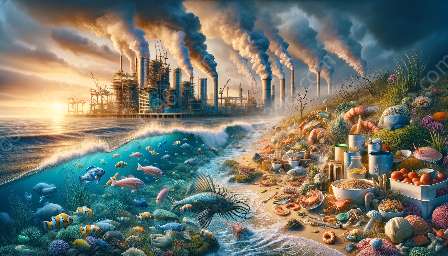Chemical pollutants in seafood can have far-reaching impacts on both the environment and human health. The contamination and pollution of seafood are issues of growing concern due to their wide-ranging effects on the marine ecosystem and seafood science. Understanding these effects is crucial in addressing and mitigating the consequences of seafood contamination and pollution.
The Effects of Chemical Pollutants on Seafood
Chemical pollutants in seafood, originating from various sources such as industrial activities, agriculture, and urban runoff, can cause significant harm to marine life and the quality of seafood consumed by humans. These pollutants can take the form of heavy metals, pesticides, pharmaceutical residues, and persistent organic pollutants (POPs).
Health Implications for Consumers
Consuming seafood contaminated with chemical pollutants can pose serious health risks to humans. Heavy metals such as mercury, lead, and cadmium that accumulate in seafood can lead to adverse health effects, including neurological and developmental disorders. Additionally, exposure to pesticide residues in seafood has been linked to adverse effects on reproductive health and the endocrine system.
Impact on Marine Ecosystem
The presence of chemical pollutants in seafood can disrupt the delicate balance of marine ecosystems. Bioaccumulation of pollutants in marine organisms can lead to abnormalities in reproductive systems, genetic mutations, and decreased population viability. Furthermore, the contamination of seafood can have cascading effects on predator-prey dynamics and food webs, affecting the overall health and biodiversity of marine ecosystems.
Contamination and Pollution Impacts
The contamination and pollution of seafood result from the cumulative effects of various pollutants that enter the marine environment. Industrial discharges, agricultural runoff carrying fertilizers and pesticides, as well as urban sewage and plastic pollution, all contribute to the degradation of seafood quality and marine habitats. These pollutants can persist in the environment for extended periods, posing ongoing threats to seafood safety and ecosystem health.
Economic Consequences
The contamination and pollution of seafood have significant economic implications for coastal communities and industries reliant on seafood resources. The presence of chemical pollutants can lead to restrictions on seafood harvesting and trade, resulting in financial losses for fishermen, aquaculture operations, and seafood markets. Moreover, the restoration of contaminated ecosystems and the implementation of pollution control measures entail substantial costs and resources.
Environmental Degradation
Chemical pollutants in seafood contribute to environmental degradation, undermining the resilience of marine ecosystems and compromising their capacity to provide essential ecosystem services. Moreover, the persistence of pollutants can lead to long-term damage to marine habitats, impacting biodiversity, water quality, and the overall integrity of coastal ecosystems.
Seafood Science and Safety
Addressing the impacts of chemical pollutants in seafood requires a multidisciplinary approach that encompasses seafood science, food safety regulations, and environmental management. Research in seafood science focuses on the monitoring of chemical contaminants in seafood, the development of sustainable aquaculture practices, and the assessment of seafood safety standards.
Regulatory Measures
Efforts to mitigate the effects of chemical pollutants in seafood encompass the implementation of regulatory measures aimed at controlling the release of pollutants into the marine environment. This includes the enforcement of water quality standards, the monitoring of seafood contamination levels, and the establishment of permissible limits for chemical contaminants in seafood products.
Consumer Awareness and Education
Raising awareness among consumers about the risks associated with seafood contamination and pollution is essential for promoting informed consumption choices. Educating the public about the sources of chemical pollutants in seafood, proper seafood handling and preparation, and adherence to food safety guidelines can contribute to reduced exposure to harmful contaminants.
Technological Advances
Advancements in analytical techniques and detection methods play a crucial role in ensuring seafood safety and quality. Innovations in seafood science, such as the development of rapid screening methods for chemical contaminants, molecular identification of seafood species, and traceability systems, aid in safeguarding the integrity of seafood products and protecting consumers.

